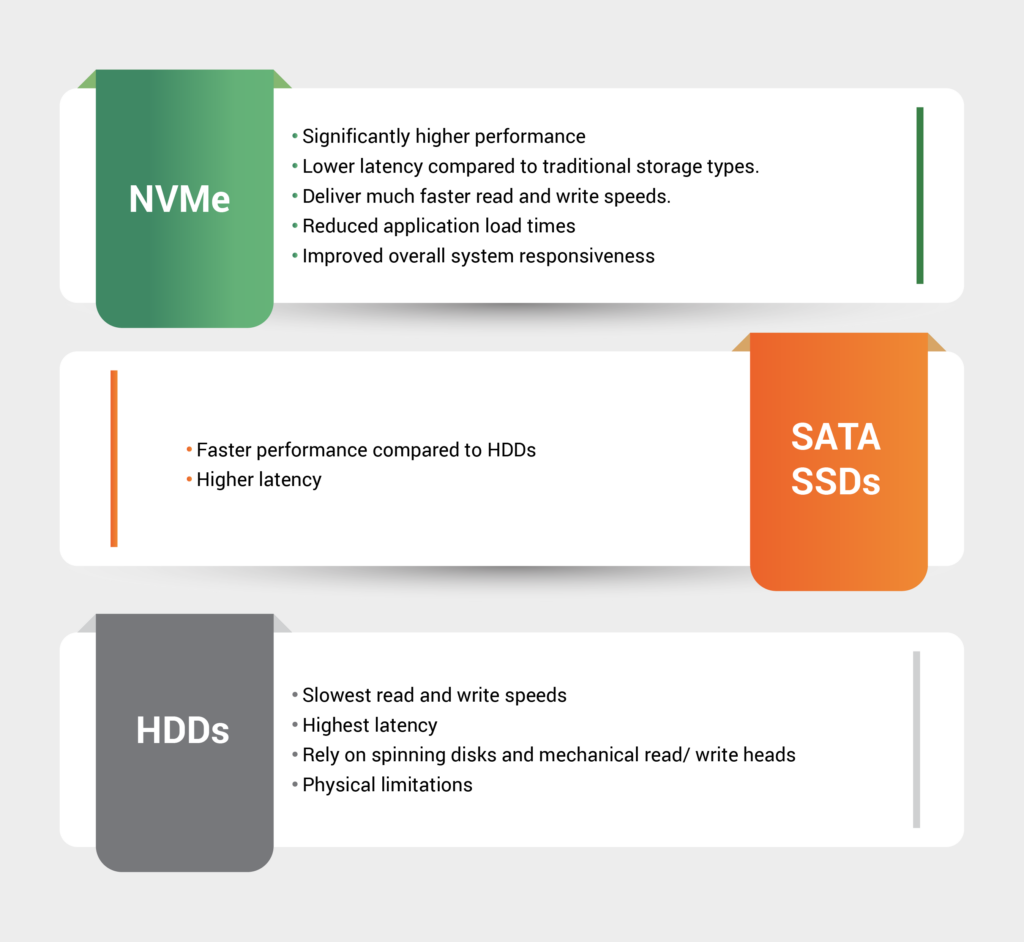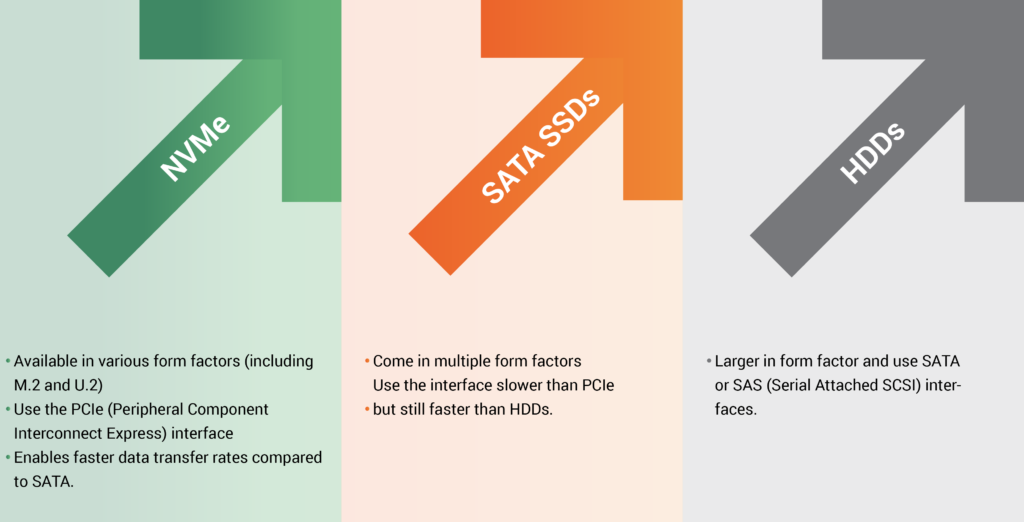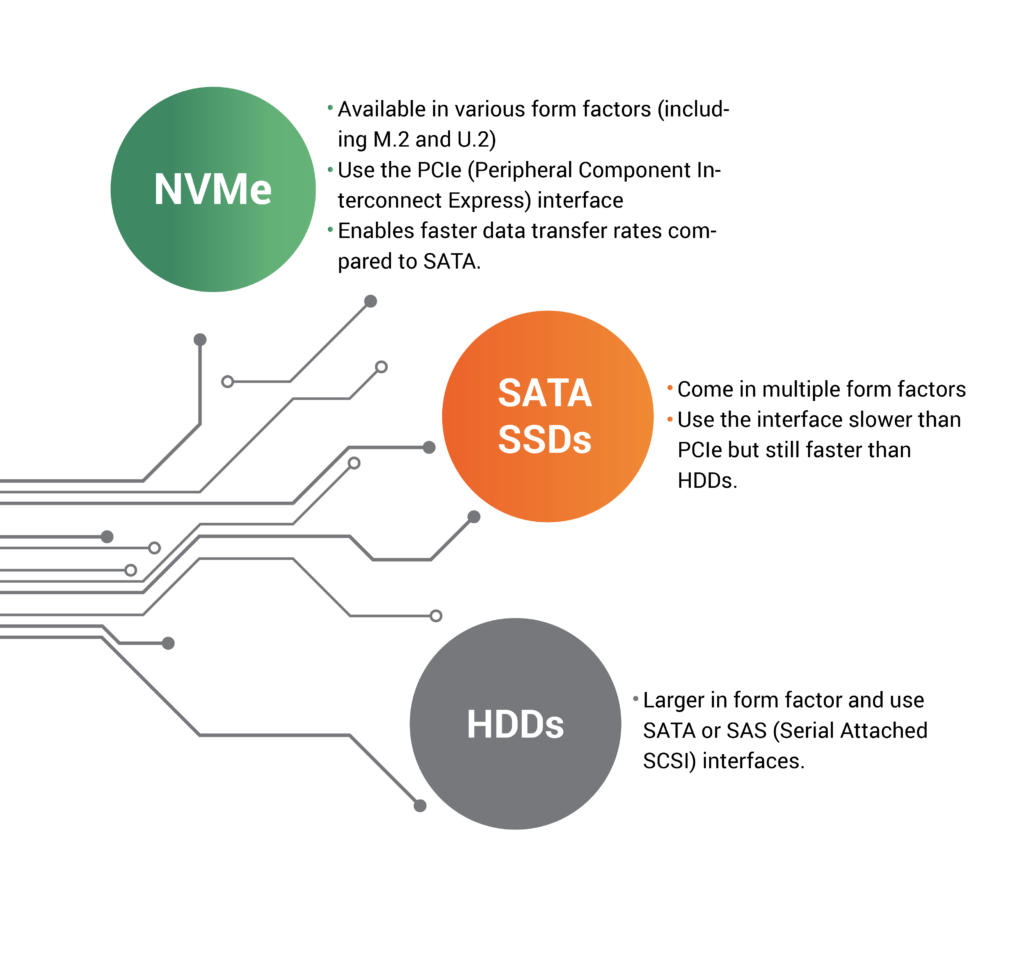NVMe (Non-Volatile Memory Express) is a modern and high-performance storage protocol designed to unlock the full potential of flash-based solid-state drives (SSDs) and other non-volatile memory technologies. Traditional storage protocols like SATA and SAS were developed initially for mechanical hard drives, leading to limitations when used with the ultra-fast access times and bandwidth capabilities of modern NAND-based SSDs. NVMe was developed to overcome these limitations, providing a streamlined and efficient interface between the host system and NVMe-based storage devices.
Key Features and Advantages:
Low Latency: NVMe significantly reduces data access latencies by minimising protocol overhead, enabling faster data transfer rates and improved application responsiveness.
High Throughput: With a focus on parallelism and scalability, NVMe achieves high throughput rates that suit demanding workloads, such as data-intensive applications and virtualisation environments.
Command Queuing: NVMe supports multiple outstanding commands, allowing the storage device to simultaneously handle numerous read and write requests, optimising I/O operations.
Efficient I/O Submission and Completion: NVMe’s lightweight command set and optimised queuing mechanisms enable efficient submission and completion of I/O operations, reducing latency.
Scalability: NVMe is designed to scale across multiple processors and cores, taking full advantage of modern multi-core CPUs and maximising system performance.
Enhanced Endurance Management: NVMe incorporates features like end-to-end data protection and wears levelling algorithms, enhancing the endurance and reliability of SSDs.
Architecture and Components:
NVMe Host Controller: This component resides in the host system (such as a computer or server) and communicates with the NVMe storage device. It handles command submission, I/O queue management, and completion notification.
NVMe Storage Device: The NVMe SSD or other non-volatile memory-based storage devices house the NVMe controller, NAND flash memory, and other necessary components. The NVMe controller manages internal operations and interfaces with the host controller.
Queues: NVMe utilises multiple queues, Submission Queue (SQ) and Completion Queue (CQ), to enable efficient command queuing and completion notification. The parallelism offered by these queues boosts I/O performance.
NVMe Commands: NVMe has a streamlined command set, including read, write, flush, and various administrative commands. The standard command set ensures compatibility and allows for optimal performance.
PCIe Interface: NVMe uses the PCIe (Peripheral Component Interconnect Express) interface for communication between the host and the NVMe storage device. PCIe provides high bandwidth and low latency, aligning with NVMe’s performance objectives.
NVMe Protocol:
Command Format: NVMe commands are compact, containing essential information such as command identifiers, data transfer details, and command-specific parameters.
Command Submission and Completion: The host system sends commands to the NVMe controller using the Submission Queue. The NVMe controller processes these commands and returns the completion status using the Completion Queue.
NVMe Namespace: NVMe organises storage into namespaces, which are logical storage space units. Each namespace can represent a partition, LUN (Logical Unit Number), or entire physical storage capacity depending on the implementation.
NVMe has revolutionised storage technology by providing a high-performance, low-latency, and scalable protocol optimised for modern flash-based storage devices. Its streamlined architecture and efficient command set unlock the full potential of SSDs, enabling faster data access and improved system performance across various applications and workloads. As technology advances, NVMe remains crucial in driving the storage industry forward.
NVMe Features in Detail:
Multi-Lane Support: NVMe supports multiple PCIe lanes, allowing for higher bandwidth and scalability. NVMe can effectively distribute data across parallel channels by utilising multiple lanes, maximising throughput and system performance.
NVMe Over Fabrics (NVMe-oF): NVMe-oF extends NVMe’s capabilities beyond direct-attached storage by enabling the protocol to run over networking fabrics like Ethernet and Fibre Channel. This facilitates the creation of high-speed, low-latency storage networks suitable for distributed storage and hyper-converged infrastructures.
Controller Memory Buffers: NVMe controllers typically feature onboard DRAM memory as a buffer for caching frequently accessed data. The presence of a dedicated memory buffer reduces the number of direct writes to the NAND flash, enhancing the overall lifespan of the SSD.
Namespace Management: NVMe allows partitioning an NVMe storage device into multiple namespaces. This feature enables the efficient sharing of a single physical device between multiple host systems or different applications, each accessing its dedicated namespace.
Power Efficiency: NVMe incorporates power management features, allowing the host system to optimise power consumption by putting the NVMe device into various power states when idle or under low utilisation.
Security Features: NVMe includes robust security mechanisms like end-to-end data protection, cryptographic features, and access control. These features help protect data integrity and confidentiality, making NVMe suitable for security-sensitive applications.
NVMe SSD Form Factors:
NVMe SSDs are available in various form factors, each designed to meet specific usage scenarios and requirements:
U.2 (2.5-inch): The U.2 form factor resembles traditional 2.5-inch mechanical hard drives, making it a suitable replacement for older storage devices in enterprise servers and data centers.
M.2 (Next Generation Form Factor – NGFF): The M.2 form factor is compact and designed for laptops, ultrabooks, and small form factor desktops. It offers a direct interface with the motherboard and enables high-performance storage in a space-efficient design.
PCIe Add-in Card: PCIe add-in cards come in various lengths and slot configurations. These cards provide higher storage capacity and performance for workstations and high-end gaming systems.
AIC (Add-In Card) Form Factor: AIC NVMe SSDs feature a more traditional PCIe card design with a heatsink for improved cooling. They are often used in data center servers and high-performance computing environments.
Advancements and Future of NVMe:
As technology progresses, the NVMe standard is expected to evolve further, incorporating new features and capabilities. Some potential advancements and trends in the NVMe landscape include the following:
PCIe Gen 5 and Beyond: NVMe will benefit from the increasing speeds of the PCIe interface. Future NVMe implementations will likely use PCIe Gen 5 and later generations to unlock even higher data transfer rates.
3D NAND and Beyond: As NAND flash technology advances, future NVMe SSDs may adopt newer generations of 3D NAND, offering higher storage densities and improved performance characteristics.
Persistent Memory: NVMe can also be adapted to work with emerging persistent memory technologies, like Intel Optane. Combining NVMe with persistent memory can lead to significantly faster data access and storage capabilities.
AI-Driven Storage: Artificial Intelligence and machine learning techniques can optimise NVMe storage performance, predict failure rates, and intelligently manage I/O patterns to improve efficiency.
NVMe has become the de facto storage protocol for modern high-performance computing systems and data centers. Its low latency, high throughput, and scalability make it ideal for addressing the demands of data-intensive applications. As the industry continues to innovate, NVMe will remain at the forefront of storage technology, enabling faster data access, increased power efficiency, and enhanced reliability for a wide range of computing environments.






